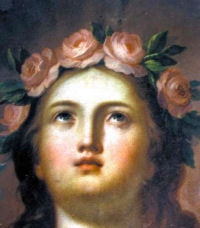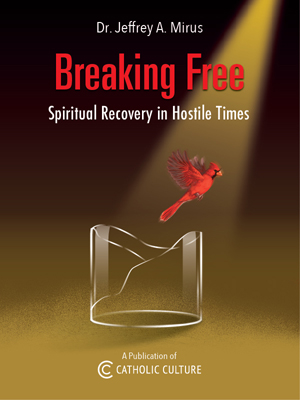Ordinary Time: September 4th
Monday of the Twenty-Second Week in Ordinary Time; Labor Day (USA)
Other Commemorations: Moses, the Prophet (RM); St. Rosalia, Virgin (RM); Bl. Marie Dina Belanger, Virgin (RM)
» Enjoy our Liturgical Seasons series of e-books!
Today's Roman Martyrology includes these commemorations:
—Moses, the Prophet whom God chose to free the Israelites who were oppressed In Egypt and bring them to the Promised Land, to whom he also revealed himself on Mount Sinai, saying, "I Am Who Am" and proposed a law that would govern the life of the Chosen People. He died on Mount Nebo of the land Of Moab died before the Promised Land.
—Saint Rosalia (1130-1160), patrons saint of her native Palermo in Sicily. For sixteen years she passed her life as a recluse in a cave on a hillside on Mount Pellegrino, three miles from Palermo, and died there at the age of thirty (A.D. 1160). She was famous for the austere penitential life and for the many miracles wrought in answer to her prayers.
—The Canadian mystic Bl. Marie Dina Belanger (1897-1929) who was beatified by Pope St. John Paul II on March 20, 1993.
Today is Labor Day in the United States of America.
Meditation on Work
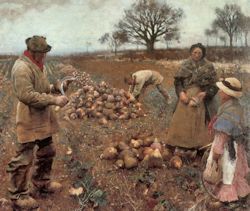 God's fundamental and original intention with regard to man, whom he created in his image and after his likeness, was not withdrawn or canceled out even when man, having broken the original covenant with God, heard the words: "In the sweat of your face you shall eat bread." These words refer to the sometimes heavy toil that from then onward has accompanied human work; but they do not alter the fact that work is the means whereby man achieves that "dominion" which is proper to him over the visible world, by "subjecting" the earth. Toil is something that is universally known, for it is universally experienced. It is familiar to those doing physical work under sometimes exceptionally laborious conditions. It is familiar not only to agricultural workers, who spend long days working the land, which sometimes "bears thorns and thistles," but also to those who work in mines and quarries, to steelworkers at their blast furnaces, to those who work in builders' yards and in construction work, often in danger of injury or death. It is also familiar to those at an intellectual workbench; to scientists; to those who bear the burden of grave responsibility for decisions that will have a vast impact on society. It is familiar to doctors and nurses, who spend days and nights at their patients' bedside. It is familiar to women, who sometimes without proper recognition on the part of society and even of their own families bear the daily burden and responsibility for their homes and the upbringing of their children. It is familiar to all workers and, since work is a universal calling, it is familiar to everyone.
God's fundamental and original intention with regard to man, whom he created in his image and after his likeness, was not withdrawn or canceled out even when man, having broken the original covenant with God, heard the words: "In the sweat of your face you shall eat bread." These words refer to the sometimes heavy toil that from then onward has accompanied human work; but they do not alter the fact that work is the means whereby man achieves that "dominion" which is proper to him over the visible world, by "subjecting" the earth. Toil is something that is universally known, for it is universally experienced. It is familiar to those doing physical work under sometimes exceptionally laborious conditions. It is familiar not only to agricultural workers, who spend long days working the land, which sometimes "bears thorns and thistles," but also to those who work in mines and quarries, to steelworkers at their blast furnaces, to those who work in builders' yards and in construction work, often in danger of injury or death. It is also familiar to those at an intellectual workbench; to scientists; to those who bear the burden of grave responsibility for decisions that will have a vast impact on society. It is familiar to doctors and nurses, who spend days and nights at their patients' bedside. It is familiar to women, who sometimes without proper recognition on the part of society and even of their own families bear the daily burden and responsibility for their homes and the upbringing of their children. It is familiar to all workers and, since work is a universal calling, it is familiar to everyone.
And yet in spite of all this toil—perhaps, in a sense, because of it—work is a good thing for man. Even though it bears the mark of a "bonum arduum," in the terminology of St. Thomas, this does not take away the fact that, as such, it is a good thing for man. It is not only good in the sense that it is useful or something to enjoy it is also good as being something worthy, that is to say, something that corresponds to man's dignity, that expresses this dignity and increases it. If one wishes to define more clearly the ethical meaning of work, it is this truth that one must particularly keep in mind. Work is a good thing for man—a good thing for his humanity—because through work man not only transforms nature, adapting it to his own needs, but he also achieves fulfillment as a human being and indeed in a sense becomes "more a human being."
Without this consideration it is impossible to understand the meaning of the virtue of industriousness, and more particularly it is impossible to understand why industriousness should be a virtue: For virtue, as a moral habit, is something whereby man becomes good as man. This fact in no way alters our justifiable anxiety that in work, whereby matter gains in nobility, man himself should not experience a lowering of his own dignity. Again, it is well known that it is possible to use work in various ways against man, that it is possible to punish man with the system of forced labor in concentration camps, that work can be made into a means for oppressing man, and that in various ways it is possible to exploit human labor, that is to say, the worker. All this pleads in favor of the moral obligation to link industriousness as a virtue with the social order of work, which will enable man to become in work "more a human being" and not be degraded by it not only because of the wearing out of his physical strength (which, at least up to a certain point, is inevitable), but especially through damage to the dignity and subjectivity that are proper to him.
—Excerpted from Laborem Exercens
Highlights and Things to Do:
- From Catholic Culture's Library:
Moses
The greatest figure in the Old Testament, the founder of Israel, lawgiver, leader, and proponent of monotheism. Of the tribe of Levi, he was born in Egypt during a persecution when all the 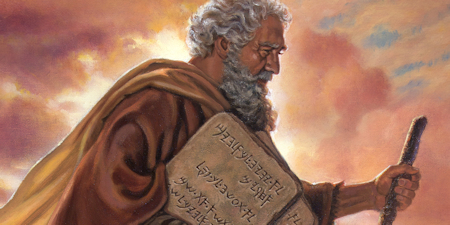 Hebrew male children were to be killed. Exposed on the Nile, he was rescued by Pharaoh's daughter and educated at court. God appeared to him in a burning bush and told him to deliver his people with the help of Aaron. The plagues did not make Pharaoh relent, until the death of every firstborn forced him to yield. Moses then led the Israelites through the years' long exodus, but he is excluded from the Promised Land because of his lack of confidence at the "Waters of Contradiction." The prophet died on Mount Nebo after pronouncing the three memorable discourses preserved in Deuteronomy. He was buried in the valley of Moab, but no one knows where.
Hebrew male children were to be killed. Exposed on the Nile, he was rescued by Pharaoh's daughter and educated at court. God appeared to him in a burning bush and told him to deliver his people with the help of Aaron. The plagues did not make Pharaoh relent, until the death of every firstborn forced him to yield. Moses then led the Israelites through the years' long exodus, but he is excluded from the Promised Land because of his lack of confidence at the "Waters of Contradiction." The prophet died on Mount Nebo after pronouncing the three memorable discourses preserved in Deuteronomy. He was buried in the valley of Moab, but no one knows where.
—Fr. Hardon's Modern Catholic Dictionary
Highlights and Things to Do:
- Read more about Moses:
- Study Michelangelo's masterpiece sculpture of Moses which is located in the church of San Pietro in Vincoli (St. Peter in Chains) in Rome.
- See Christian Iconography for portrayals of Moses.
- Become more familiar with the Old Testament by listening to the Bible in a Year Podcast (with Fr. Mike Schmitz) put out by Ascension Press.
St. Rosalia
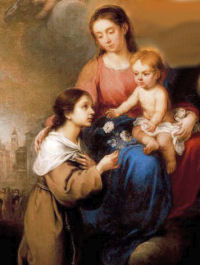 St. Rosalia is the patroness of Palermo, and the citizens of that place annually celebrate two feasts in her honour. One of these was raised to the rank of a holy day of obligation by Pius XI in 1927. It is celebrated by a procession of unequalled magnificence, heralded by cannon fire. The saint's shrine, atop a gigantic carriage filled with musicians, is drawn through the town by forty mules, accompanied by prayers, hymns, and acclamations. The top of the carriage is level with the roofs of the houses; fireworks are set off everywhere; the musicians blow ceaselessly on their trumpets; and for the five days during which this celebration lasts, enthusiasm mounts to an increasingly high pitch.
St. Rosalia is the patroness of Palermo, and the citizens of that place annually celebrate two feasts in her honour. One of these was raised to the rank of a holy day of obligation by Pius XI in 1927. It is celebrated by a procession of unequalled magnificence, heralded by cannon fire. The saint's shrine, atop a gigantic carriage filled with musicians, is drawn through the town by forty mules, accompanied by prayers, hymns, and acclamations. The top of the carriage is level with the roofs of the houses; fireworks are set off everywhere; the musicians blow ceaselessly on their trumpets; and for the five days during which this celebration lasts, enthusiasm mounts to an increasingly high pitch.
The saint of Palermo thus honoured, seems to have delivered her country from the plague in 1625 and, since then, to have brought about innumerable cures. Her legend states that she was born around 1130 at the court of Roger II, king of Sicily, of a father called Sinibald, who was descended from Charlemagne. As her beauty constituted a danger to her soul, the Virgin appeared to her to urge her to leave the world. Rosalia was just fourteen. She took her crucifix, her discipline, and a few books and left her father's castle by night. Two angels, one armed like a knight, the other disguised as a pilgrim, were waiting to escort her to the summit of Mount Quisquita. There they left her at the entrance of a grotto hidden among the trees, buried under the snow. The young girl remained hidden there several months, after which the angels came to warn her that she was sought by her parents and had better flee elsewhere. They led her to the top of Mount Pellegrino. There, it is said, Rosalia, devoting herself to penances and miraculously nourished by the Host, passed the last sixteen years of her life. She died at the age of thirty; her body, long sought in vain, was found in the 17th century encased in a sheath of rock crystal; and it is the recovery of this relic which is commemorated by the procession mentioned above.
— Excerpted from Lives of the Saints, Omer Englebert
Patronage: Locations in Sicily: Baucina, Benetutti, Bivona, diocese of Caltagirone, Campofelice di Roccella, Delia, Isola delle Femine, Lentiscosa, Palermo, Pegli, Racalmuto, San Mango Cilento, Santo Stefano Quisquina, Sicily, Vicari
Symbols and Representation: A young girl with a wreath of roses; receiving the wreath from the Blessed Virgin and Christ Child as angels bring roses and with a skull near her; with a distaff, book, and palm; holding a double Greek cross, distaff and book or palm; or writing her name on the wall of the cave
Highlights and Things to Do:
Bl. Dina Bélanger
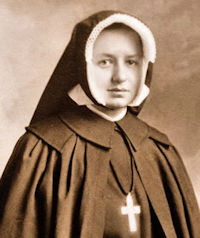 Dina Belanger was born in Quebec City on April 30, 1897. She was the only daughter of Seraphia Matter and Olivier Belanger. She attended elementary and secondary school with the sisters of the Congregation of Notre Dame at their convent in Saint Roch and then at Jacques Cartier School. At the age of 14, she asked whether she could be a boarder at Bellevue Convent, where she wanted to complete her studies. She made the following prayer: “O my God, grant that, during my stay here, I may not offend you by even the least serious sin.” Also at 14, she consecrated her virginity to God.
Dina Belanger was born in Quebec City on April 30, 1897. She was the only daughter of Seraphia Matter and Olivier Belanger. She attended elementary and secondary school with the sisters of the Congregation of Notre Dame at their convent in Saint Roch and then at Jacques Cartier School. At the age of 14, she asked whether she could be a boarder at Bellevue Convent, where she wanted to complete her studies. She made the following prayer: “O my God, grant that, during my stay here, I may not offend you by even the least serious sin.” Also at 14, she consecrated her virginity to God.
When she finished school, she returned to live with her parents and studied piano. She developed a personal rule of life that was based on prayer, mass, communion, the rosary, and meditation, and kept it all a secret. She helped her mother with the parish’s outreach to the poor and the sick. She was active in the Work of the Tabernacles (its members made altar cloths and liturgical vestments for poor parishes and for the missions). She became an active member of the Apostleship of Prayer and joined the Third Order of St. Dominic. In 1916, she was admitted to the New York Conservatory, where, for two years she studied advanced piano and harmony. When she returned to Quebec, she gave concerts and continued to study of harmony by distance education.
When she was 24, she entered the novitiate of the Religious of Jesus and Mary in Sillery. She took the habit the next year under the name of Marie Sainte-Cecile de Rome, and made renewable vows on August 15, 1923. That September, she was appointed as music teacher at the Convent of Saint-Michel-de-Bellechasse on the south shore of the St. Lawrence River, across from the Island of Orleans. Her stay there was interrupted by bouts of illness.
From the age of 11, Dina had deep prayer experiences and an intimate relationship with the Lord. Her superior in the community asked her to keep a journal of her spiritual experiences, which she began to do in 1924. She pronounced perpetual vows on August 15, 1928. The following April, she had to go the infirmary. She died on September 4, 1929, at age 32, the victim of pulmonary tuberculosis which had first been diagnosed in the spring of 1926.
Dina Belanger was beatified by Pope (now Saint) John Paul II on March 20, 1993, at the same time as Saint Claudine Thevenet, the founder in France of the religious congregation to which Dina belonged.
Dina was sensitive and had a delicate conscience that at times was troubled with scruples. As a child, she learned how to lift herself to God in prayer, in the silence and beauty of nature. She made first communion when she was 10 and from that time she sought recollection, meditation, and intimacy with Jesus. She expressed it thus: “Only God! Like the deer that pants for running streams, so my soul sighs for you, O my God! My God, I am suffering because I am not suffering. I am dying, because I am not dying.”
She received abundant grace, and prayed ever more fervently and performed acts of love as Jesus communicated himself to her by voices and visions. She thirsted for silence, and had to force herself to socialize with other teenagers. “I was a person of extremes,” she would later write in an autobiography, “and once I started on something good, I would decide to take it as far as I could.” But her independent nature meant that she struggled with her “selfish desire for isolation and peace."
As a student, Dina loved every subject. She was passionate about art and the beautiful and her aim was always perfection: “I wanted to find the God-given talents within me,” she wrote, but her ideals were so high that she never felt she deserved the praise she received. She was naturally oriented to meditation, and did not believe that she would find spiritual nourishment in books: “Jesus himself gave this to me. He presented the book from which shone forth to my eyes, in large letters, the secret of happiness and the knowledge of love.” The Autobiography of Saint Therese of Lisieux helped her learn how to abandon herself to God.
At the beginning of the Great War, “afflicted with the moral evil” that threatened the world, she offered herself to the Lord in a spirit of reparation and love, “in order to console him a little and to save souls.” She had moments of inner turmoil and had to struggle against her “sharp and sometimes angry nature” so that her desire to excuse herself would not triumph. As a novice, she offered herself as a victim, martyr and apostle in union with Mary following the example of Father (now Saint) Louis de Montfort.
Her spiritual life deepened as she discovered the depths of the Trinity: “For God to be able to pour his grace in profusion into the soul of a person, he has to find Jesus living in them. … To become an abyss able to be filled with the Infinite, one must be open to the annihilation of one’s being on the level of the spirit.” She was given a deep understanding of the presence of Jesus in the Eucharist. Jesus revealed to her that “you will not possess me any more fully in heaven, because I have completely absorbed you.”
Dina was open to apostolic and missionary life and had a strong desire to help others, especially priests and religious, deepen their relationship with Jesus. “In all my actions, my words, my thoughts, and my desires I find myself to be passive, as if under the influence of the Supreme Being, as if the Spirit of Love had his soft yet strong guiding hand on me. My freedom is total, and in that state there is no conflict. His grace is simply so strong that I cannot resist.” Her sole occupation became one of continually directing her attention to God. “Have confidence in my mercy. It is because you are weak and unhappy that I have chosen you,” Jesus said to her, as she recounts in her autobiography. Her union with him was so profound that she could write, “Jesus Christ lives in place of me on earth. He has substituted himself for me, and now I am nothing.” Thus she was one with the apostle Paul who wrote, “It is not I who live, but the Christ who lives in me.”
—Excerpted from Canadian Conference of Catholic Bishops
Highlights and Things to Do:


